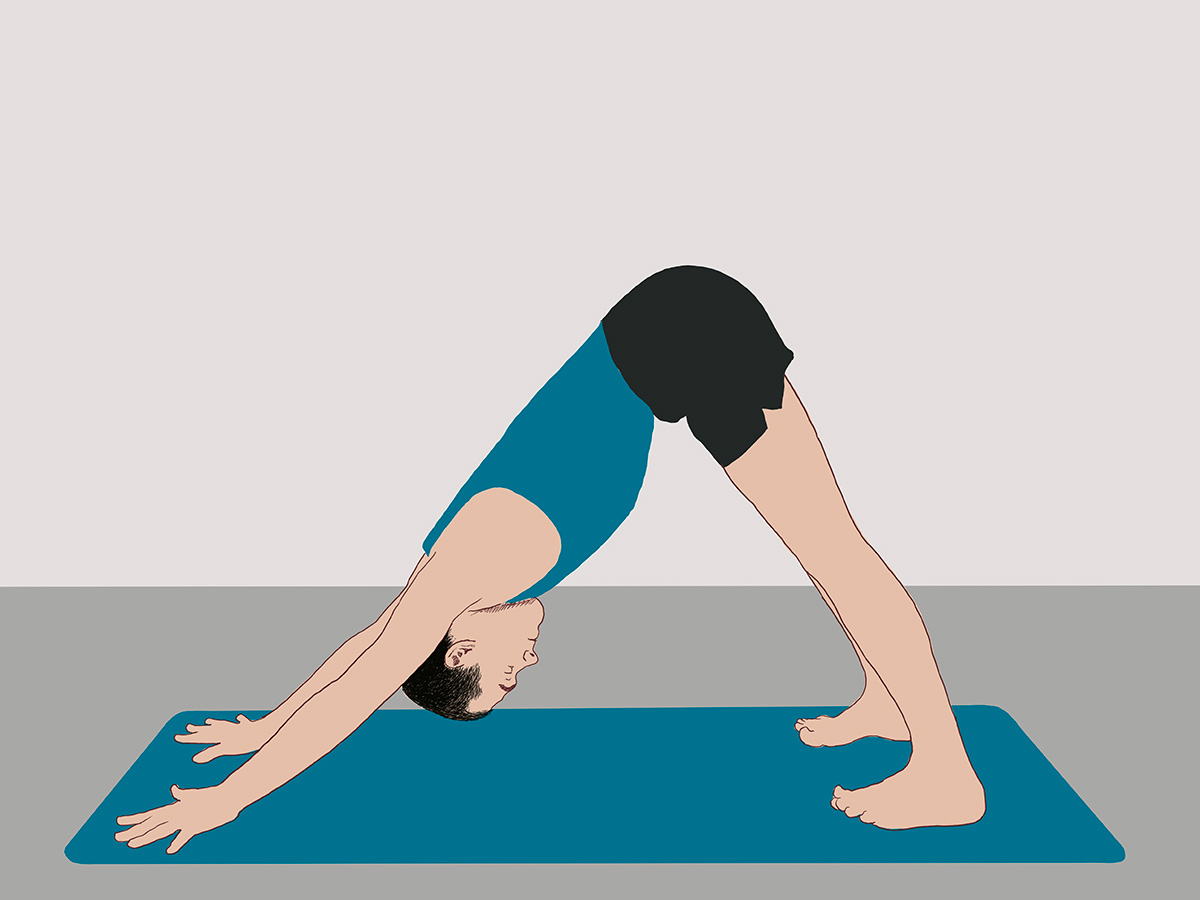Downward Facing Dog Pose (Adho Mukha Svanasana): A Complete Guide to this Foundational Yoga Pose
Downward Facing Dog Pose — or Adho Mukha Svanasana — is one of the most recognisable and widely practiced yoga poses. It’s a mild inversion that builds strength, increases flexibility, decompresses the spine, and energises both body and mind. In its fullest expression, the pose forms a symmetrical triangle: hips lifted high, arms and legs extended, and the spine lengthening in both directions.
In this in-depth guide, we’ll break the pose down step-by-step. Whether you’re a beginner learning the basics, or an experienced practitioner refining your technique, this blog will help you establish strong foundations, improve alignment, and deepen your understanding of this essential asana. You’ll explore multiple variations using props like blocks, chairs, and a wall — all drawn from the methodical and detail-oriented approach of Iyengar Yoga.
Explore a World of Online Yoga. Unlimited Access to All Classes and Courses.
Try it Free for 14 days. Cancel Anytime.
Step-by-Step Video Class: Explore Adho Mukha Svanasana in Depth
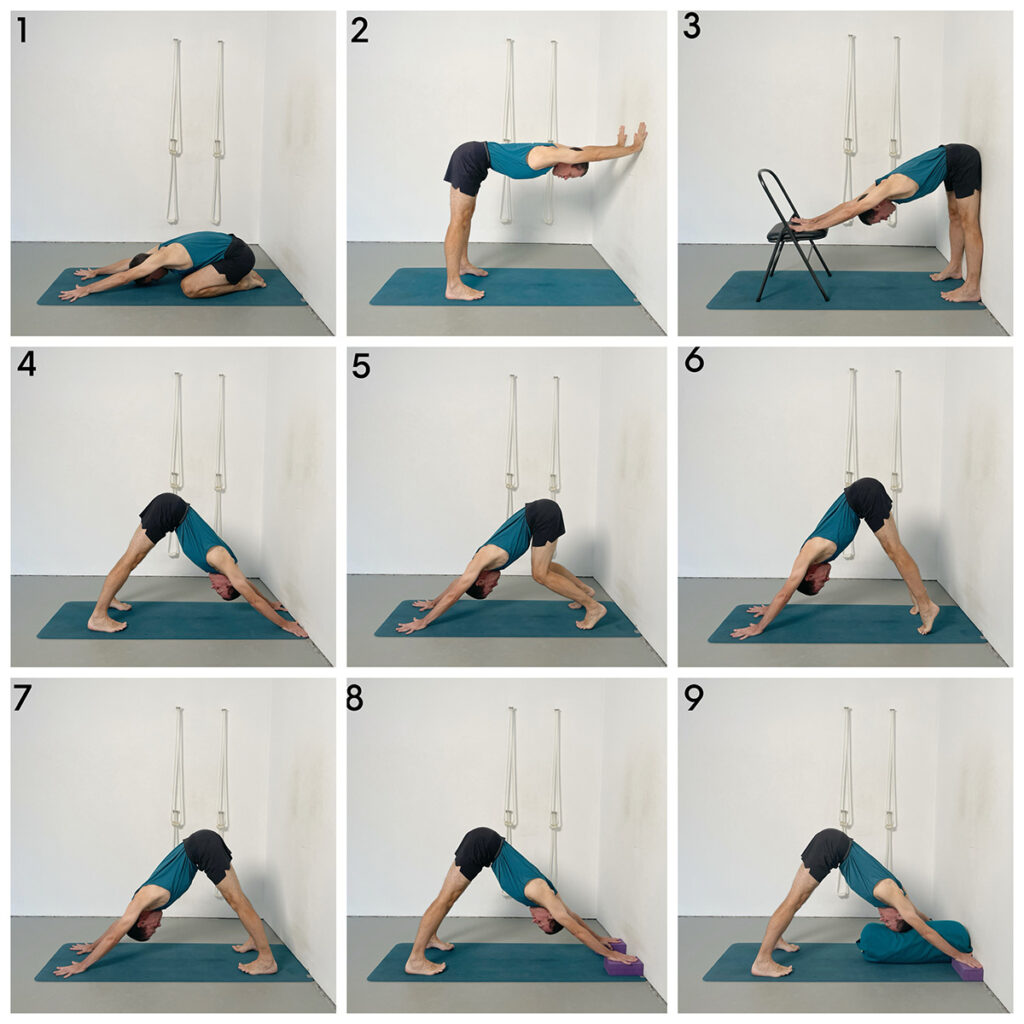
This focused, tutorial-style class offers a deep dive into Adho Mukha Svanasana (Downward Facing Dog Pose), one of yoga’s most foundational asanas. Designed to enhance both technique and understanding, it guides you through a carefully structured progression of variations that reduce muscular strain and accommodate flexibility restrictions—giving you the freedom to explore the pose more fully.
You’ll begin by isolating key actions in simplified preparatory versions of the pose. These actions are then layered and synchronised to gradually build an integrated and effective practice. The class develops essential techniques for how the hands and arms work in coordination with the feet and legs, helping you establish correct alignment and improved balance of effort across the body.
As well as checking fundamental basics such as the ideal distance between hands and feet, this class deepens your overall understanding of Adho Mukha Svanasana, making it ideal for both refining the pose and building upper and lower body strength. A great option when you’re short on time but want to practice mindfully and intelligently.
👉 Watch the class on Yoga Selection
Essential Props for Exploring the Pose
Using props can transform your relationship with Downward Dog. In this practice, you’ll need:
- A chair
- Two blocks
- A bolster
- Wall space
Props allow you to better understand alignment, reduce over-efforting, and adapt the pose to your body’s needs — especially if you’re working with stiffness, injury, or fatigue.
Building the Pose: Step-by-Step Variations and Techniques
1. Adho Mukha Virasana: Establish Arm-Leg Connection
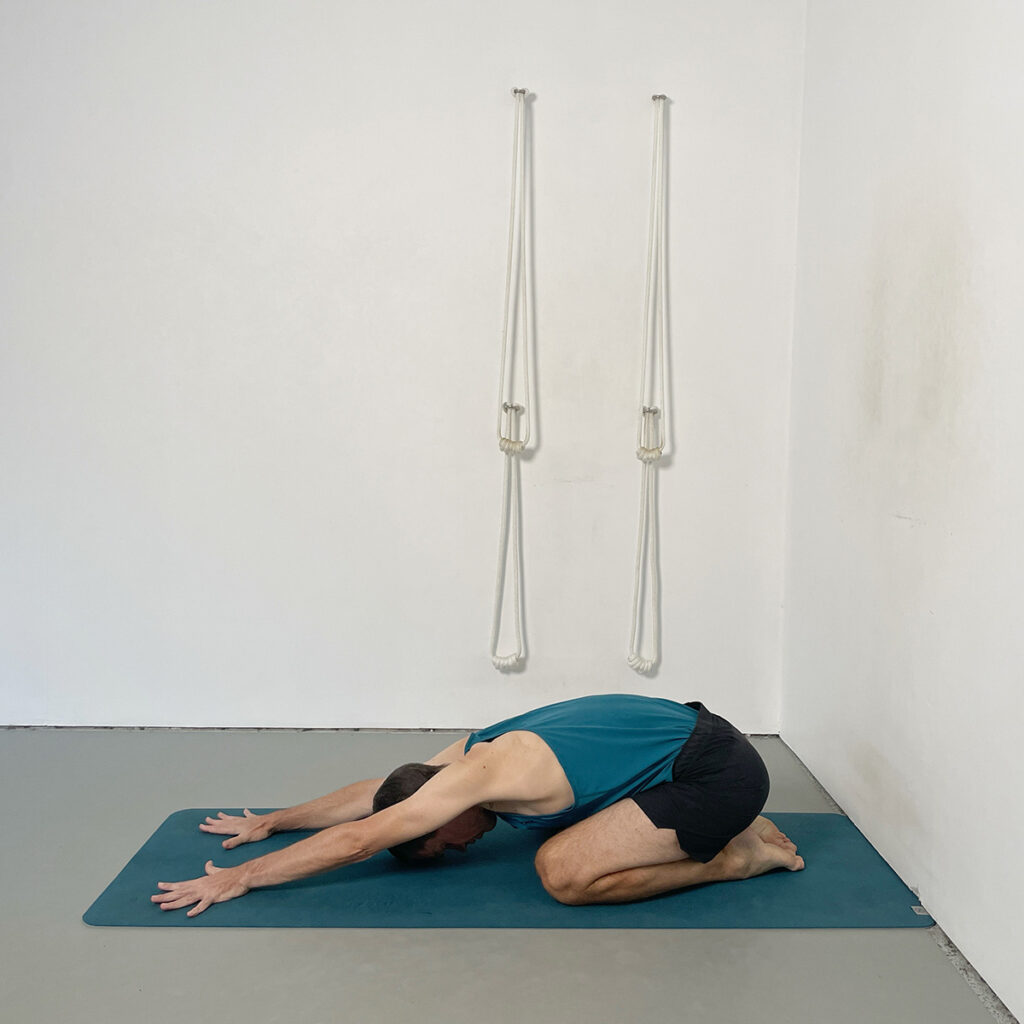
Start in Adho Mukha Virasana to feel the relationship between your hands pressing into the mat and your hips moving back towards your heels. This foundational action will echo throughout every variation of Downward Dog.
Key Actions:
- Keep the hips anchored to the heels as you reach the arms forward, maintaining a grounded base.
- Press the hands firmly into the floor, using the arms to help move the hips back and down.
- Stretch the arms forward without letting the hips lift, creating traction along the spine.
- Allow the forehead to rest—either on the floor or support—while maintaining engagement in the arms and awareness in the breath.
2. Half Dog Pose at the Wall
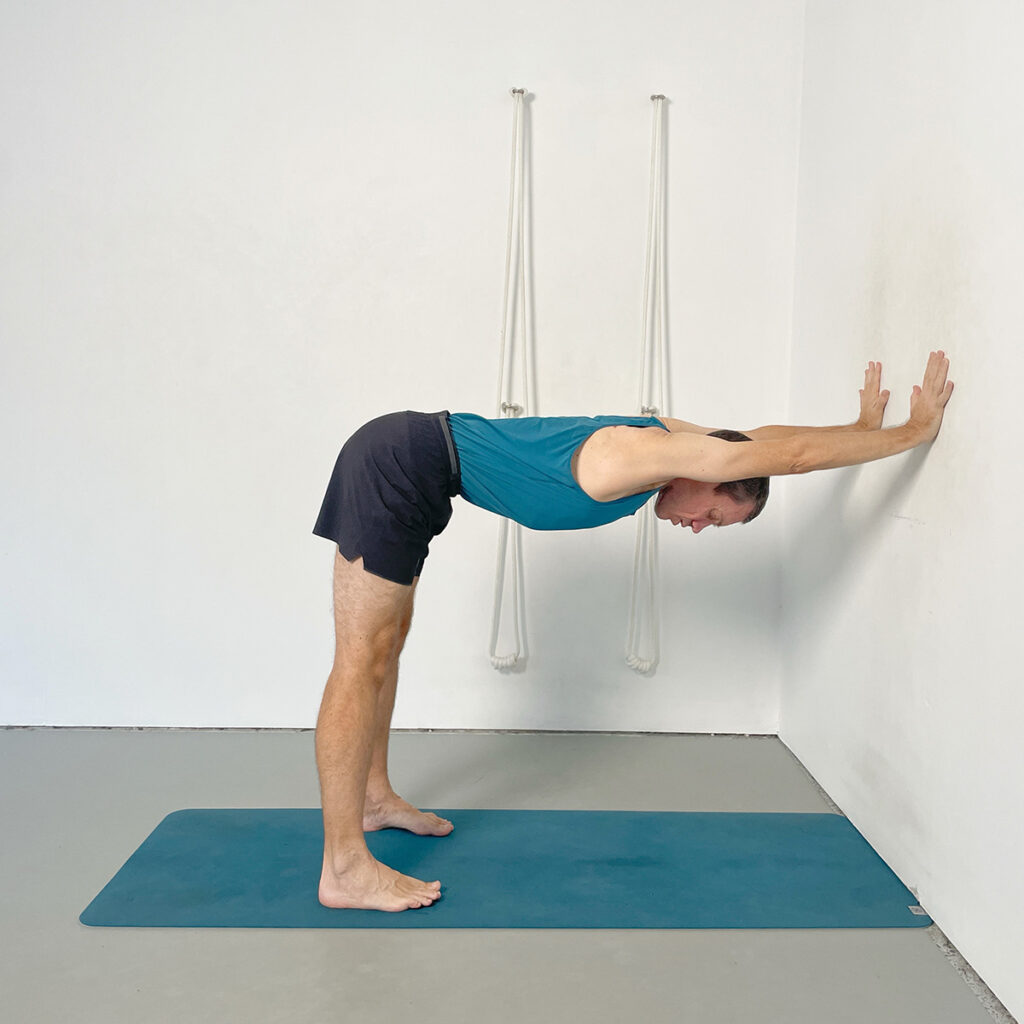
This variation simplifies the pose by removing weight-bearing effort, allowing you to focus on developing length in the spine, precision in arm action, and integration between the upper and lower body.
Key Actions:
- Place your hands shoulder-width apart on the wall at hip height, with your index fingers pointing upward.
- Step back and align your body into an L-shape, forming a right angle at your hips.
- Press the hands firmly into the wall, especially through the index finger base.
- Simultaneously grip your thighs and push your legs back, lengthening from hands to hips.
- Keep your elbows lifted, upper back broad, and avoid dipping in the lower back by drawing the pubic bone back and the sacrum away from the spine.
3. Chair Variation: Hands on Chair
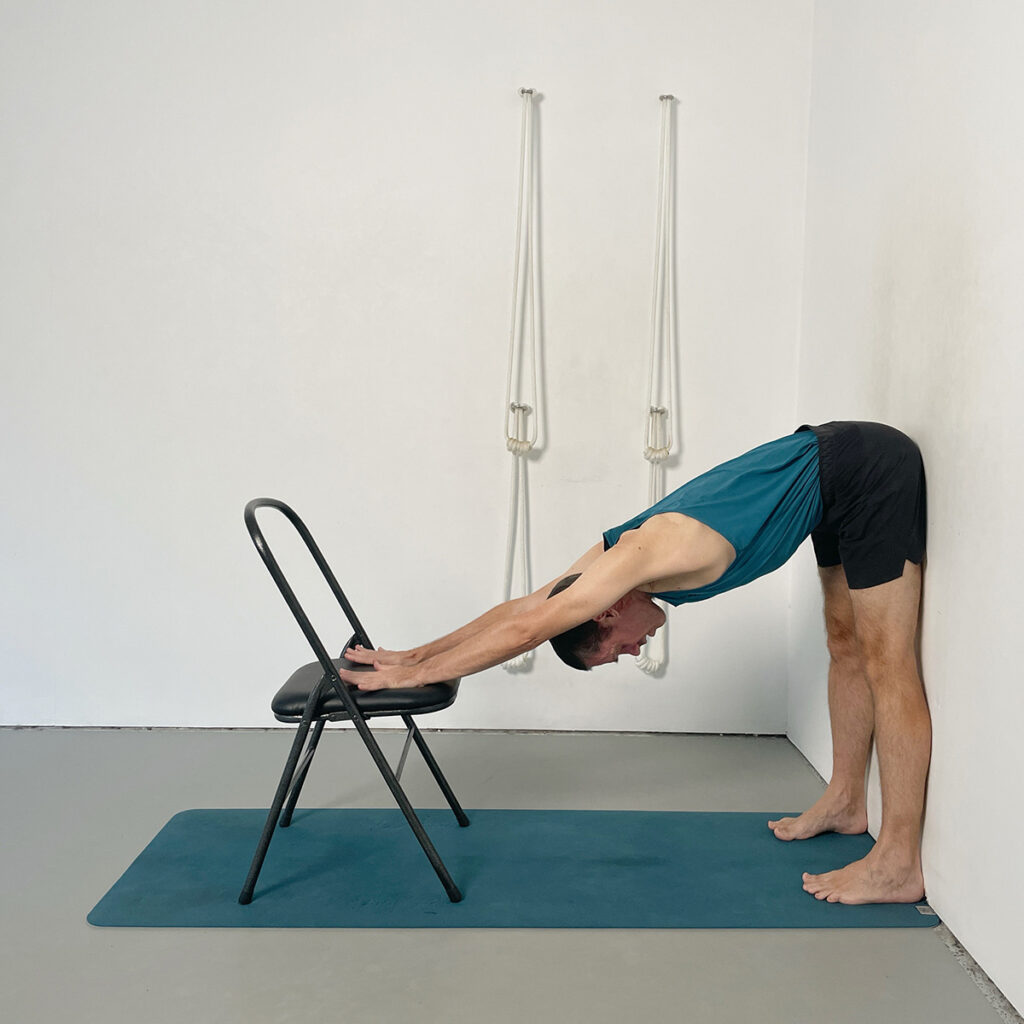
This variation provides clear reference points for alignment and helps you feel the integrated action of pressing the hands down and the legs back to lift and extend through the pelvis and spine.
Key Actions:
- Place your hands flat on the seat of the chair, shoulder-width apart.
- Step your feet back until your heels, backs of knees, and sitting bones touch the wall.
- Press your hands down into the chair as if pushing it away from the wall.
- Simultaneously press your thighs back into the wall to encourage lift in the pelvis.
- Engage your heels by pressing them into the floor to stabilize and energize the legs.
4. Thumb and Index Finger to the Wall
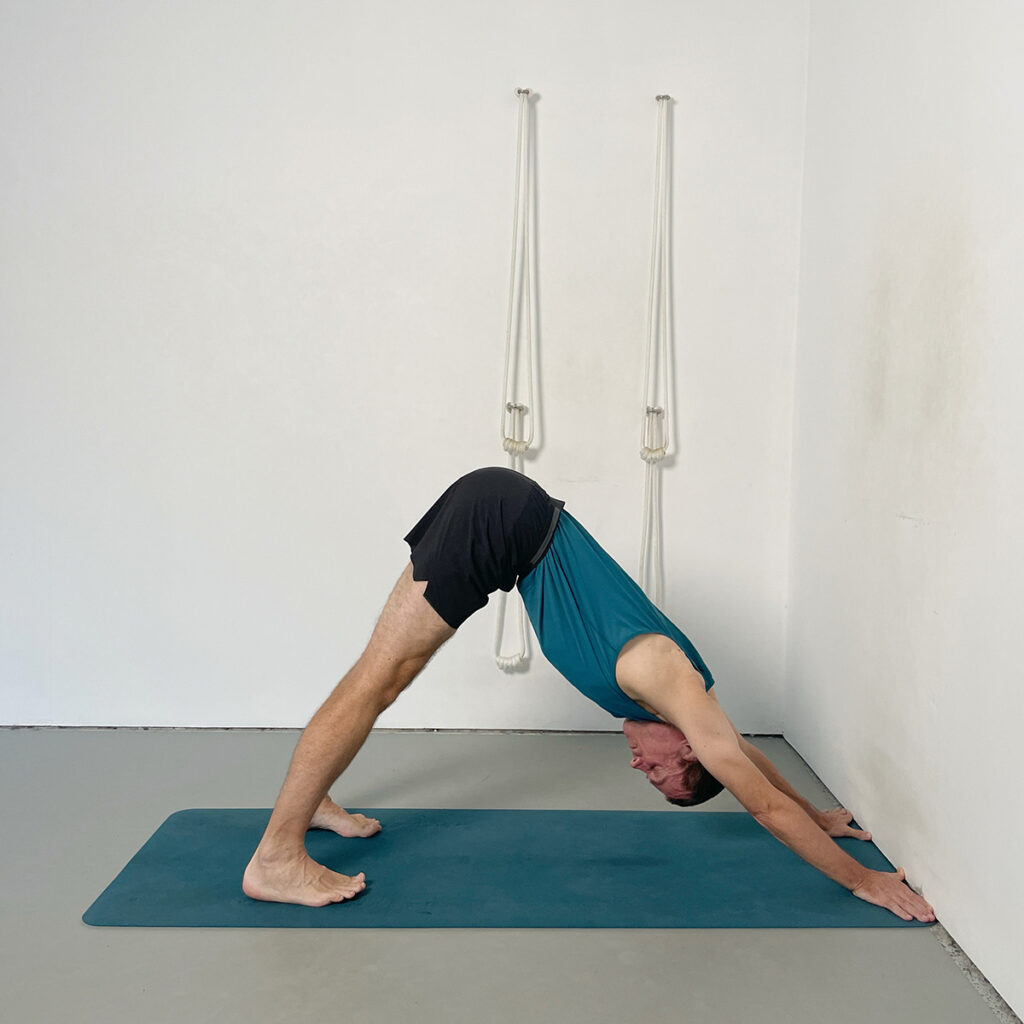
The wall provides a fixed point of resistance, helping to activate and lengthen the side ribs, stabilise the hands, and deepen the connection between the arms, spine, and pelvis.
Key Actions:
- Place your hands on the floor shoulder-width apart, with the thumb and index finger touching the wall.
- Tuck your toes under and press your hips up and back into Downward Dog.
- Press your thumbs firmly into the wall to energize and lift the side ribs.
- Grip the thigh muscles and draw the tops of the thighs back to lengthen the spine.
- Press your heels toward the floor while maintaining lift in the sitting bones.
5. Adho Mukha Svanasana From Adho Mukha Virasana
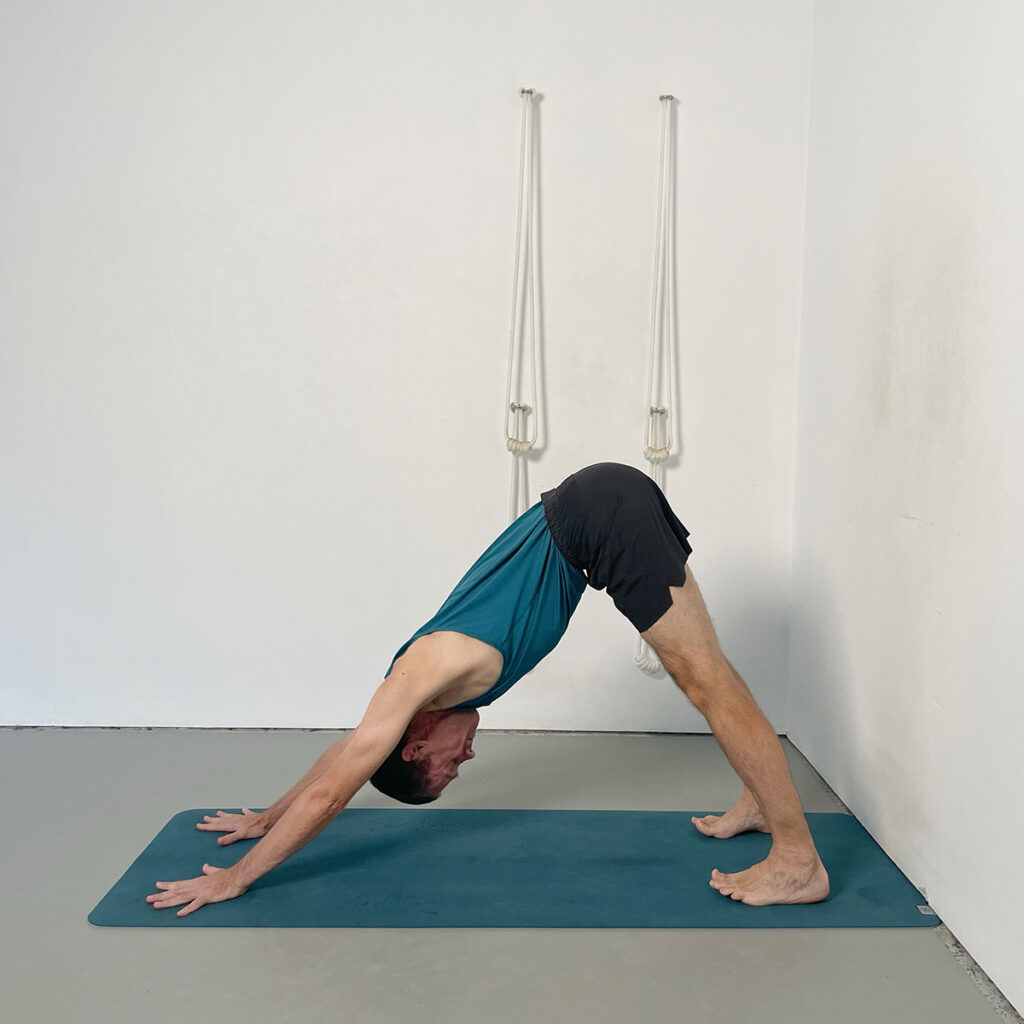
This method helps establish correct distance between the hands and feet, reinforces spinal length from the start, and creates a smooth, balanced transition into the full pose.
Key Actions:
- Begin in Adho Mukha Virasana with arms extended forward and hips resting on the heels
- Tuck the toes under and shift the shoulders forward over the wrists
- Keep the knees bent as you lift the hips and draw the thighs back
- Press the hands firmly down and stretch the mat away to lengthen the spine
6. Dog Pose Modifications: Bent Knees
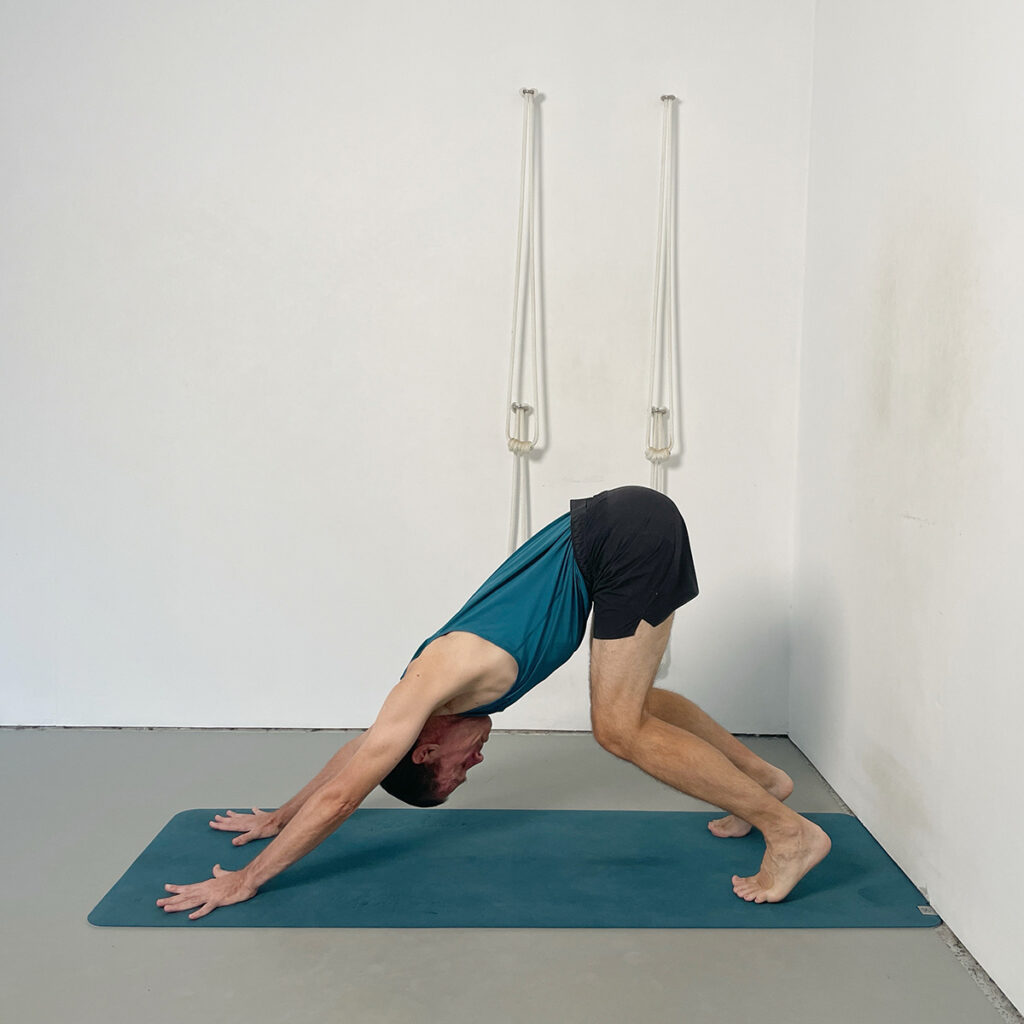
Bending the knees reduces tension in the hamstrings and calves, making it easier to access the spinal length and pelvic lift that are key to the pose.
Key Actions:
- Come into Downward Dog and slightly bend both knees
- Keep the heels lifted off the floor
- Press the hands down and stretch the mat away to lift the side ribs and pelvis
- Draw the tops of the thighs deeply back into the hip sockets
6. Dog Pose Modifications: Raise heels
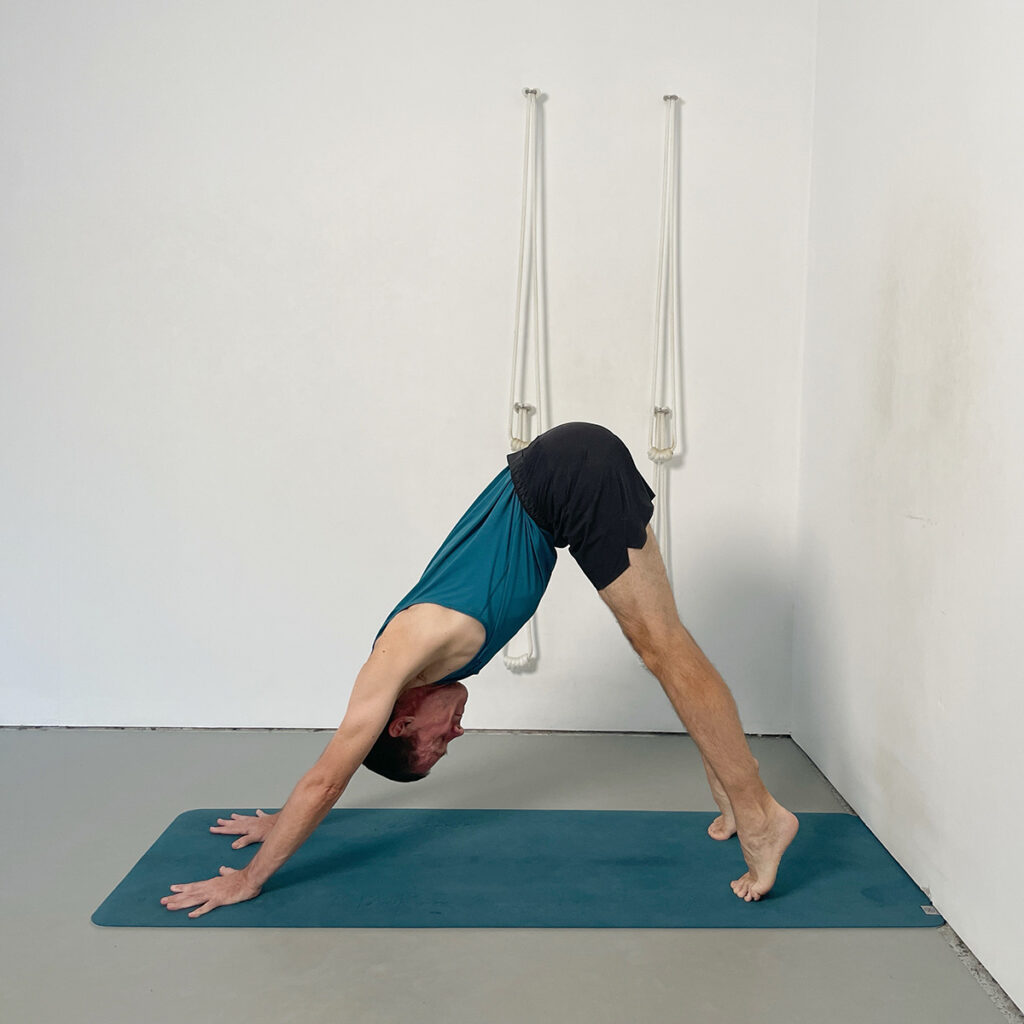
Raising the heels helps prevent the base of the pelvis from dropping, allowing you to maintain spinal traction while building mobility in the calves and ankles.
Key Actions:
- In the full pose, lift both heels high off the floor
- Keep the legs straight and the hips lifted over the ankles
- Press the hands down and stretch the spine upward
- Maintain the lift of the sitting bones as you gradually lower the heels
7. Using Blocks Under Hands
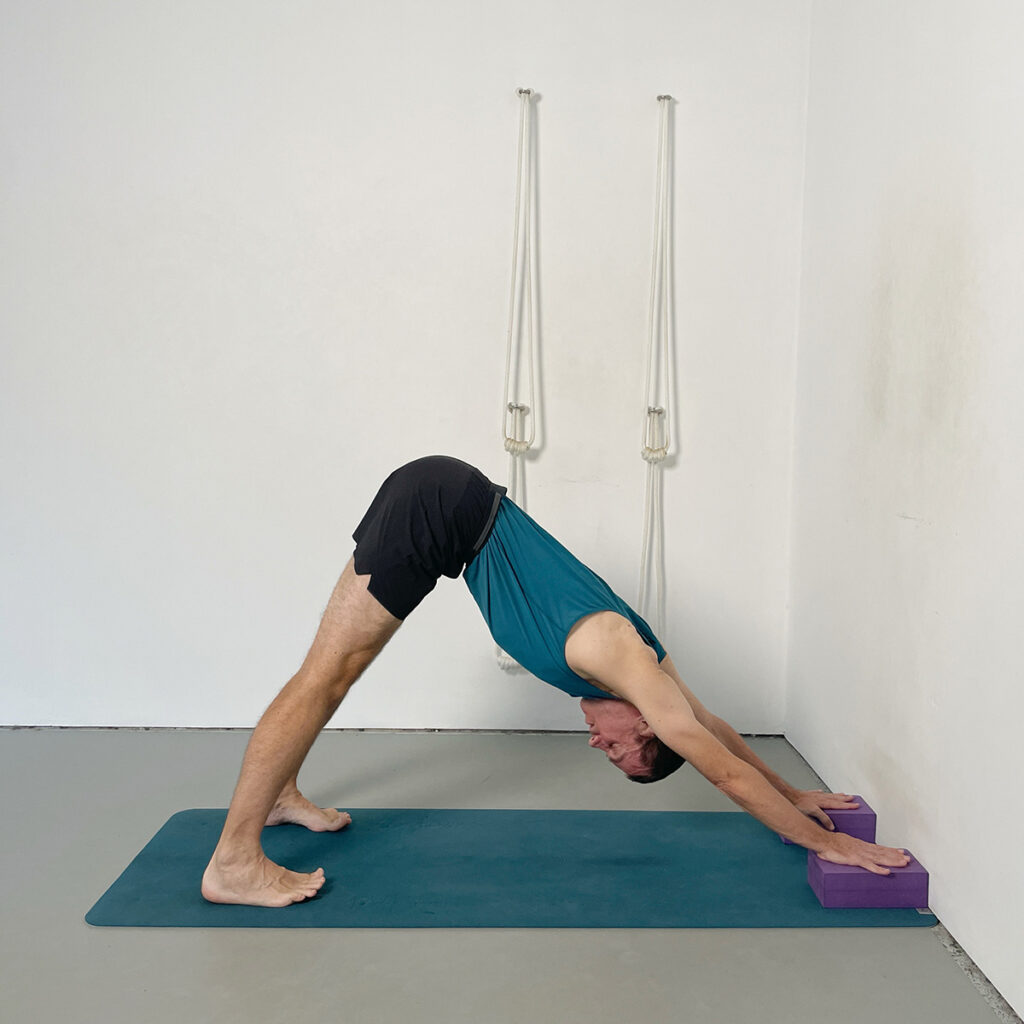
Elevating the hands reduces load on the arms and shoulders, improves leverage through the legs, and allows the heels to ground more easily — especially helpful for tight hamstrings or wrist sensitivity.
Key Actions:
- Place blocks flat on the floor against the wall, shoulder-width apart
- Set your hands on the blocks, fingers spreading wide
- Press the hands down and forward as if pushing the blocks into the wall
- Keep the arms straight and lift the pelvis as you draw the thighs back
8. Supported Restorative Version with Bolster
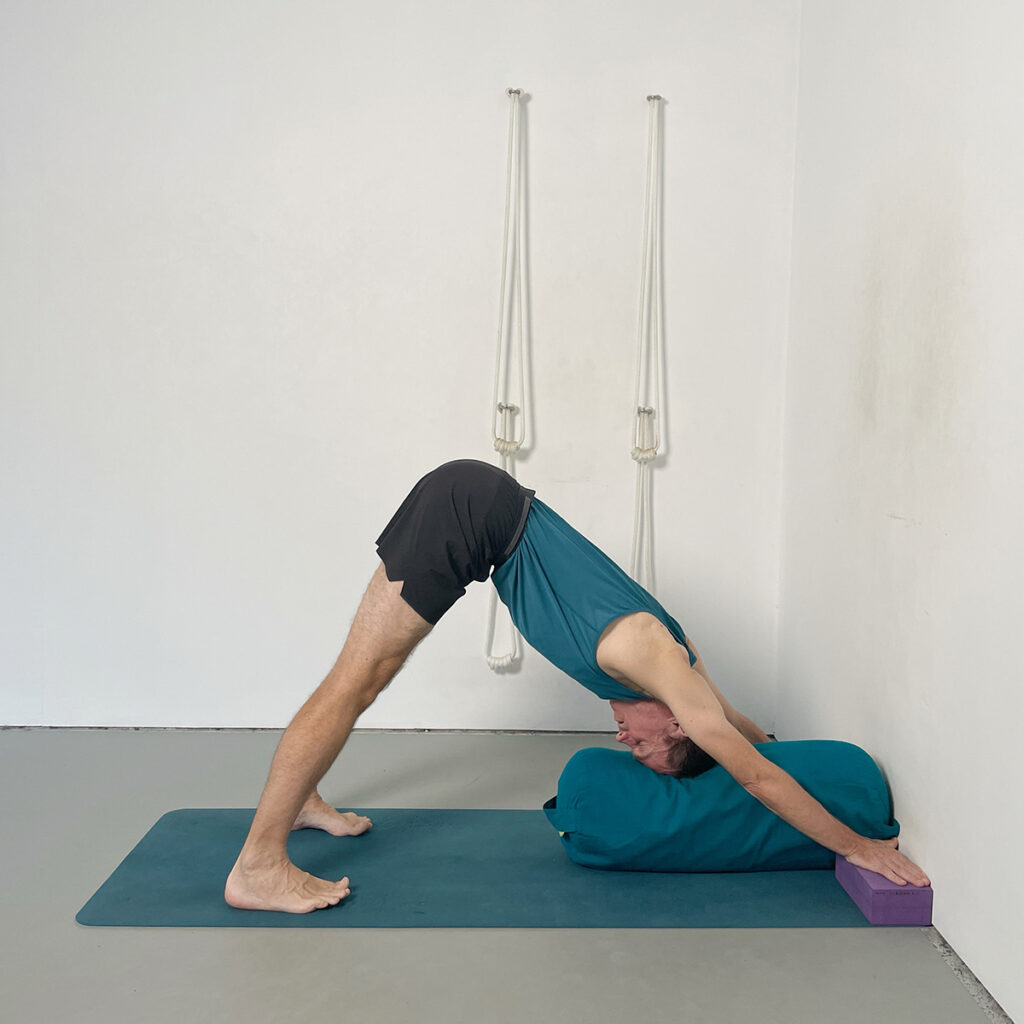
This supported variation reduces muscular effort, promotes deeper breath awareness, and makes the pose accessible during times of low energy or recovery, while still reinforcing alignment.
Key Actions:
- Place a bolster between two blocks against the wall to support the forehead
- Set your hands on the blocks with thumbs and index fingers touching the wall
- Press the hands down and lift the side ribs and pelvis
- Let the forehead rest gently on the bolster while keeping the legs active
Four Fundamental Actions in Downward Facing Dog:
Press the hands down
– This action initiates lift through the arms and spine, creating space and traction from the fingertips to the pelvis.
Firm and draw the thighs back
– Activating the quadriceps and moving the tops of the thighs back helps to lift the hips and extend the spine fully.
Press the heels down in coordination with the hands and thighs
– When the hands press down and the thighs move back, grounding the heels completes the pose’s directional flow. This synchronised action balances the effort across the entire body and stabilises the base without collapsing the pelvis.
Let the head hang and soften the neck
– Releasing the neck allows the spine to lengthen naturally and encourages a balanced, calming effect.
Frequently Asked Questions
Do my heels need to touch the floor?
No. It’s more important that your spine lengthens and your pelvis lifts than forcing your heels down. Over time, with consistent practice, the heels may gradually lower.
What’s the benefit of using a chair or wall in Downward Dog?
These props provide feedback and support that help clarify alignment, reduce muscular strain, and teach how different parts of the body work together.
Should I keep my knees bent or try to straighten them?
Start with a slight bend in the knees if it helps you lift the pelvis and maintain spinal length. Straighten the legs gradually without compromising the shape of the pose.
Can Downward Dog be a Resorative Pose?
It can be — once strength and flexibility have been developed. Beginners may find it effortful, but supported versions can offer a restorative effect.
How do I know the correct distance between my hands and feet?
Begin in Adho Mukha Virasana (Extended Child’s Pose) and extend your arms forward without lifting your hips. This establishes an ideal and personalised hand-to-foot distance when transitioning into Downward Dog.
Final Thoughts on Downward Facing Dog Pose
Downward Facing Dog is a dynamic and adaptable pose that rewards steady attention and thoughtful practice. Whether you’re working with props, refining alignment, or modifying for your body’s needs, the key actions explored in this guide will help you move with greater clarity and confidence. Each variation offers new insights, making the pose both a learning tool and a place of integration within your practice.
🎥 Click here to watch the Downward Facing Dog Pose Tutorial
Explore Yoga Selection’s Library Today
With over 900 online Iyengar Yoga classes classes and two new videos added each week, Yoga Selection offers a dynamic resource to support your growth as a practitioner. Explore our Yoga Selection Weekly Classes Page to find classes that match your goals and discover new insights in your practice.
Whether you’re revisiting foundational poses, diving into advanced techniques, or exploring therapeutic support, Yoga Selection’s online Iyengar Yoga classes will empower every aspect of your journey. Join our community today and take your practice to new levels of depth and understanding.
Explore a World of Online Yoga. Unlimited Access to All Classes and Courses.
Try it Free for 14 days. Cancel Anytime.
Share:
See Related Blog Posts:
